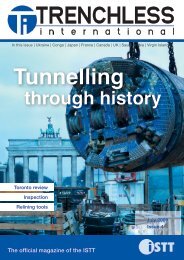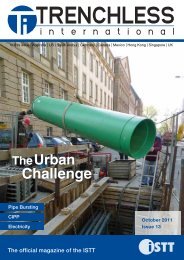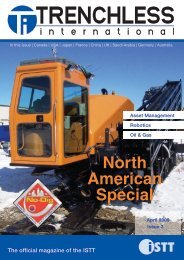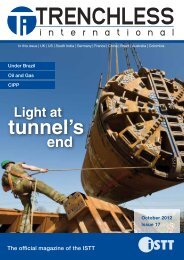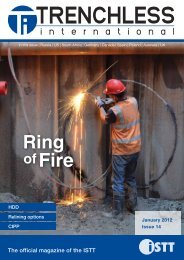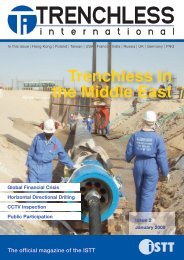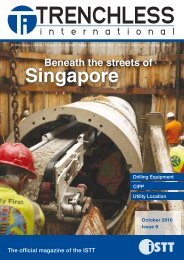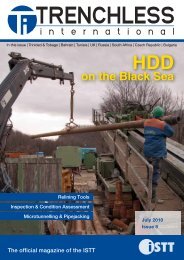Boring - Trenchless International
Boring - Trenchless International
Boring - Trenchless International
Create successful ePaper yourself
Turn your PDF publications into a flip-book with our unique Google optimized e-Paper software.
projetcs<br />
April 2010 - <strong>Trenchless</strong> <strong>International</strong><br />
Green machine<br />
saves the day<br />
In the Polish city of Kielce a HDD rig, featuring second<br />
generation ADBS and a new type of backreamer, has<br />
successfully completed a crossing in sandy clay<br />
ground conditions.<br />
The project involved a 76 metre<br />
length of HDPE pipe OD 160 mm installed<br />
using horizontal directional drilling (HDD)<br />
to leave a busy, central area undisturbed.<br />
Kielce-based project contractor Ekobox<br />
Sp. z.o.o. specialises in installations of<br />
telecom power lines and road lighting,<br />
using trenchless pipe and cable laying<br />
The TERRA-JET 4015 S during the<br />
pilot bore.<br />
techniques. The company has a history working with piercing<br />
tools and has recently complemented their fleet with the addition<br />
of the HDD machine; TERRA-JET (TJ) 4015 S.<br />
Ekobox owner Mr Suchansky selected the premium TJ<br />
model, which is equipped with an air conditioned driver’s<br />
cabin, an MP3 player and an on-board computer with touch<br />
screen. The width of the operator’s cab allows the seat to<br />
rotate 180 degrees. Manufacturer TERRA AG says that the<br />
computer saves every metre of the bore as it prints out a bore<br />
protocol with all torques, pulling and thrust forces, and also the<br />
drilling fluid volume and pressures. The touch screen gives all<br />
the information the operator requires, says the company.<br />
The drill operator drives and operates the HDD machine using<br />
two multifunctional joysticks installed in the left and right armrests<br />
of the operator’s seat, allowing control and smooth movement of<br />
the rig.<br />
The TERRA-JET 4015 S can drill directional bores up to<br />
200 metres length and 460 mm diameter, depending on ground<br />
conditions. It is driven by a 62.5 kW (85 HP) powered diesel<br />
engine, which is ‘clean’ and fulfils the required ‘green’ emission<br />
regulations for some years to come.<br />
Torque and pullback force are produced by separated<br />
hydraulic circuits allowing the maximum torque of 4,000 Nm<br />
(3,000 ft.lbs) and the maximum pullback force of 150 kN<br />
(15 tonnes, 33,000 lbs) to be used simultaneously under full load.<br />
The drilling fluid volume is 90 litres per minute (23 gpm) at<br />
a maximum fluid pressure of 70 bars (1,000 psi). The drilling<br />
The HDPE pipe OD 160 mm is pulled in.<br />
The new 215 mm TERRA back reamer<br />
with tungsten carbide teeth.<br />
fluid volume may be optionally increased. The system which<br />
mixes the bentonite into the drilling fluid via an injector (Venturi<br />
hopper) is on board the HDD machine. This patent removes the<br />
need for an extra mixing system and a second engine.<br />
The TERRA-JET 4015 S is equipped with a second generation<br />
Automatic Drilling and Backreaming System (ADBS). This patented<br />
ADBS automatically and within milliseconds adjusts the<br />
working speed of the drill to suit the ground conditions says the<br />
company. In soft ground the drill operates at maximum speed, in<br />
hard ground slowly, but always at the optimum speed.<br />
Machinery in action<br />
The 76 metre long pilot bore in the sandy clay was achieved<br />
with ease. The drill head could even be located underneath the<br />
reinforced concrete plates. Said the contractor.<br />
After the pilot bore the drill head was replaced by a new back<br />
reamer 215 mm. TERRA has developed this new type of backreamer<br />
with tungsten carbide teeth, which can be replaced easily<br />
every time. This new backreamer has an integrated protection<br />
pipe for the swivel, which closes the space between the backreamer<br />
and the HDPE pipe. Therefore preventing stones from<br />
falling in front of the expander chuck and block the backreaming.<br />
With the backreamer the HDPE pipe OD 160 mm (6.3 inch) was<br />
pulled in simultaneously, proving no problem for the rig.<br />
Mr Suchansky said “The new design and concept makes<br />
the TERRA-JET Series S to one of the most productive HDD<br />
machines available.”<br />
Coating shafts –<br />
substrate preparation perfected<br />
by Rainer Hermes<br />
For an effective and long-lasting – and hence economical – shaft coating, careful and thorough cleaning and<br />
preparation of the substrate is essential.<br />
Hermes Technologie, based in Schwerte, Germany,<br />
has been successfully developing coating procedures using<br />
ERGELIT dry mortars for over 20 years, launching the KS-ASS<br />
(M-Coating) process on the market in the late 1990s, and very<br />
quickly complementing it with an automated shaft cleaning rig.<br />
Named the TSSR, this is an array of high pressure cleaning nozzles<br />
which form part of the M-Coating equipment and are raised<br />
and lowered in the shaft mechanically, to achieve thorough<br />
preparation of the substrate.<br />
Continuous market observation and monitoring of client reaction<br />
led to a ‘high speed’ version of the TSSR at the end of 2006.<br />
The company said that at 380 bar and 24 litres per minute and<br />
with a completely new design of rotary nozzles, shaft cleaning<br />
equipment was now developed almost to perfection. Almost –<br />
there were still some questions to answer.<br />
How to treat hard clinker brick surfaces, new concrete shafts<br />
or synthetic coatings before coating with ERGELIT? Intensive<br />
research and experimentation finally led to the conclusion that<br />
only sand-blasting could provide a satisfactory solution. But how?<br />
By exposing operatives to conditions in the shaft?<br />
Anyone who has ever seen such an operating procedure can<br />
understand this would ran counter to the thinking behind the<br />
M-Coating process of which the TSSR was an integral part. When<br />
developing the M-Coating process, the Hermes team has given<br />
the same priority to protecting the workforce as to improving<br />
performance when it came to shaft rehabilitation. The M-Coating<br />
name became virtually synonymous with fast, effective and top<br />
quality shaft coating with ERGELIT. This was and still is the<br />
reason why this, and only this, process has received the Berlin<br />
DiBT’s certificate for coating wastewater collectors and inspection<br />
shafts.<br />
In the autumn of 2009, the Hermes team’s technicians and<br />
engineers found the solution to the sand-blasting problem: developing<br />
the TSSR into the HDS jet equipped with a combination of<br />
water- and sand-blasting technology. The new process amazed<br />
the professionals at the ENTSORGA show in 2009.<br />
This apparatus, registered with the German patent office<br />
under the name HDS-jet, is equipped with two water/sand<br />
blasting nozzles. Operation is as the TSSR. The array rotates<br />
through 360 degrees on its own axis and is raised and lowered<br />
by winch. Working on the venturi principle, the high pressure<br />
water pump creates a strong vacuum which in turn draws the<br />
blasting sand out of the container.<br />
The sand is then accelerated so powerfully through the nozzle<br />
that it keys or prepares tiles, new concrete surfaces or synthetic<br />
surfaces so that the new ERGELIT coating makes a permanent<br />
bond. Thanks to the short, uniform and easily adjustable distance<br />
between the nozzle and the shaft wall, the blasting sand, with<br />
carefully selected grain size, gives very even results.<br />
The speed at which the HDS jet cleans is around 15 minutes<br />
per metre. That is, it normally takes one hour to complete the<br />
cleaning and preparation of a standard four metre deep shaft<br />
with these problematic shaft walls. In exceptional cases the<br />
procedure can be repeated several times, depending on the<br />
sandblasting finish required.<br />
There is no need to send operatives into the shafts, which is<br />
particularly important where these are narrow or difficult. Often<br />
it is only the M-Coating procedure that can cope with major<br />
projects – for example, a 25 metre deep shaft in London could<br />
not have been renovated without this technique. As is the case<br />
with the usual TSSR cleaning, the specialist operatives stand at<br />
the top of the shaft and monitor the cleaning process or top up<br />
the blasting sand if required.<br />
The new water/sandblasting equipment is proposed as a<br />
complete kit, or as an add-on to the M-Coating equipment. As<br />
usual, the HERMES Technologie team will demonstrate the HDS<br />
jet and explain the operational method and particular technical<br />
and economical features on the spot. Poorly cleaned substrates,<br />
however bad they originally were, should now be a thing of the<br />
past. The economic problems of coating breaking off because of<br />
inadequate substrate preparation can now be avoided. The technology<br />
is available and simply needs to be applied. For clients<br />
already using M-Coating, this is simply an important addition to<br />
existing technology. HERMES Technologie ensures a powerful<br />
bond and a highly durable coating.<br />
pipe cleaning<br />
April 2010 - <strong>Trenchless</strong> <strong>International</strong><br />
46<br />
47




